December 2003 (Part 2)
SELECTION OF QUESTIONS AND ANSWERS
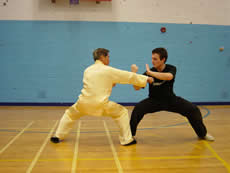
This and the photographs below show some combat applications from “Mang Fu Ha San” or “Fierce Tiger Descends Mountain”. Here Sifu Wong attacks Ronan with a “Low Stance Cannon Punch” against which Ronan responds with “Bar the Big Boss”.
Question 1
I noticed you had a webpage relating to “Mang Fu Ha San” at /review/mountain.html. I was wondering if this particular form was a form from your Hung Gar system. I would love to know a little of the history of your form if it is permissible.
— David, USA
Answer
Your question will be valuable to those interested in the historical background of Hoong Ka Kungfu. Yes, you are right. Many of the patterns in the set “Mag Fu Ha San”, which means “Fierce Tiger Descends Mountain”, are taken from my Hoong Ka system, although we usually refer to our Hoong Ka system as Southern Shaolin.
The most famous lineage of the Hoong Ka or Hung Gar system today is that from the great kungfu master Wong Fei Hoong, who lived from 1847 to 1924, which was at the end of the Qing Dynasty and the beginning of the Republican period in China. But both Wong Fei Hoong and his successor Lam Sai Weng did not refer to their kungfu as Hoong Ka; they called it Shaolin.
It is also interesting to note that while all Hoong Ka exponents acknowledge that their system is called Hoong Ka after the great Shaolin master Hoong Hei Khoon, Wong Fei Hoong's lineage leads back not to Hoong Hei Khoon but to another great Shaolin master Loh Ah Choi. Hoong Hei Khoon was the senior classmate of Loh Ah Choi under the Venerable Chee Seen, the abbot of the southern Shaolin Monastery at Nine Lotus Mountain in Fujian, and First Patriarch of Southern Shaolin Kungfu.
This fact that the source of Wong Fei Hoong's lineage was Loh Ah Choi and not Hoong Hei Khoon, does not negate the claim by exponents of his lineage that their system is Hoong Ka, because the art practiced by Hoong Hei Khoon and Loh Ah Choi was the same.
As the three famous kungfu sets of Wong Fei Hoong were “Taming the Tiger”, “Tiger-Craane” and “Iron-Wire”, many people thought these were the only orthodox Hoong Ka sets. This is not so. When I was learning kungfu from Uncle Righteousness in Penang (in Malaysia) in the 1950s, there was a famous Hoong Ka master named Ng Siew Hoong, who was respectfully known as Hoong Pak, or “Elderly Uncle Hoong”. His famous Hoong Ka sets were “Four Gates” and “Tiger Claws”.
In the 1960s I heard of an old and much respected Hoong Ka master (whose name I cannot remember) in a remote part of Malaysia. His kungfu sets were “Fierce Tiger Descends Mountain”, “Night Tiger Emerges from Forest” and “Essence of Shaolin”.
I also learned “Four Gates” from my sifu, Sifu Ho Fatt Nam, and “Essence of Shaolin” from my sifu, Uncle Righteousness. My “Four Gates” is different from that taught by Elderly Uncle Hoong, but my “Essence of Shaolin” is the same as that taught by the other old Hoong Ka master, though there was no connection between that old master and Uncle Righteousness. “Four Gates” is reputed to be the fundamental set taught at the open square in the southern Shaolin Monastery, and “Essence of Shaolin” was the most advanced set taught to selected disciples.
Nevertheless, the “Fierce Tiger Descends Mountains” (Mang Fu Ha San) shown in my webpage is not a classical set passed down by masters; it is a set consisting of various combat sequences composed by me. I choose the name “Fierce Tiger Descends Mountains” because it expresses well the philosophy, spirit and skills embodied in this set where the Single Tiger Claw and the Double Tiger Claws are used in qin-na (gripping) techniques.
It may be of interest to note that in our Shaolin Wahnam school, we do not learn any classical sets in our basic training programme, which consists of 12 levels of about 3 or 4 years of regular training. Kungfu sets like “Fierce Tiger Speeds Through Valley” and “Happy Bird Hops up Branch” are a result of our combat sequence training.
Although “Fierce Tiger Descends Mountain” is not at our basic stage but at our intermediate stage of training, it is also a result of our sparring practice. After this, we move to classical sets like “Four Gates”, “Five Animals”, “Tiger-Crane” and “Dragon and Tiger” at our intermediate stage, and to other classical sets like “Eighteen Lohans”, “Flower Set” and “Dragon's Strength” at our advanced stage. At whatever stages, set practice is a means, and not an end, of our kungfu training.
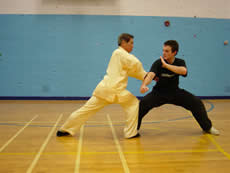
As soon as Ronan blocks the first right cannon punch, Sifu Wong brushes aside Ronan's right arm and executes a second left cannon punch.
Question 2
I have a form of the same name from my late Sigung who would have learnt it in Toisan, between 1915 and 1940 perhaps. Ours appears to be a form passed from Leung Tien Chu of Toisan. He developed a Fut Gar system also known as Hung Tao Choy Mei (I think).
Answer
I do not know about Leung Tien Chu of Toisan, but he might be one of the masters from the lineage of Hoong Hei Khoon, or one of his classmates like Foong Sai Yoke and Wu Wai Thien. I believe that “Mang Fu Ha San” and “Ye Fu Chuit Lam” (“Fierce Tiger Descends Mountain” and “Night Tiger Emerges from Forest”) could be two of the few sets practiced by masters from the Hoong Hei Khoon lineage.
In his later years Hoong Hei Khoon taught Shaolin Kungfu at “Siu Lam Hoong Kwoon” (Hoong School of Shaolin Kungfu) in Guangdong Province of south China. It was from Siu Lam Hoong Kwoon that the term Hoong Khuen (Hoong Kungfu) or Hoong Ka Khuen (Hoong Family Kungfu) is derived.
Hoong Hei Khoon's three most outstanding disciples were Hoong Mang Ting, Chow Yien Kit and Wu Ah Piew. Hoong Mang Ting was Hoong Hei Khoon's son. Wu Ah Phiew was Wu Wai Thien's son whom Hoong Hei Khoon adopted as his own son after Wu Wai Thien was killed by Ko Chun Choong, the military governor of Guangdong and Guangxi, and Pak Mei's outstanding disciple. Hoong Mang Ting, using the Crane Style he learned from his mother Foong Chet Leong, and Wu Ah Phiew using mainly the Tiger Style he learned from Hoong Hei Khoon, joined effort to kill Pak Mei to avenge the burning of the southern Shaolin Monastery at Nine-Lotus Mountain.
The style of kungfu taught by Hoong Hei Khoon, which is now popularly known as Hoong Khuen or Hung Gar, became very famous in south China. In the early twentieth century kungfu masters from Toisan (a district capital in south China) and other parts of Guangdong spread Hoong Khuen to South-East Asia and North America. It would throw much light to the history of Hoong Khuen if your lineage traced back to one of these masters.
It is less likely that “Mang Fu Ha San” was passed down by Fong Sai Yoke or Wu Wai Thien. Both died young (Fong Sai Yoke was killed by Pak Mei) and might not have any disciples. Both their specialty was “Mui Fa Khuen” (Plum Flower Set), more popularly known as “Fa Khuen” (Flower Set).
Fatt Ka (Fat Gar) Kungfu is similar to Hoong Ka Kungfu, except that the palm rather than the tiger claws are more frequently used. It is another style of Southern Shaolin Kungfu, probably transmitted by the Venerable Sam Tuck, one of Chee Seen's disciples
Chen Harng combined Fatt Ka, Choy Ka and Li Ka into one system now known as Choy-Li-Fatt. It was popularized by his disciple Cheong Hoong Seng, and is taught in Hoong Seng Kwoon (Hoong Seng Kungfu School) in many parts of the world.
Hoong Tao Choy Mei means “starting with Hoong Ka and completing with Choy Ka Kungfu”. It is also called Chow Ka Kungfu as it was initiated by Chow Loong.
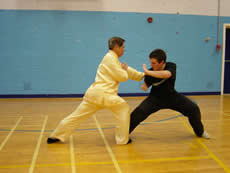
Ronan rotates his waist and jerks his right elbow backward to deflect Sifu Wong's left cannon punch. Notice that Ronan's left hand guards against Sifu Wong's arm against any possible attack.
Question 3
My “Mang Fu Ha San” features numerous repetitions of the left Cat Stance and left outstretched palm. Photo number 26 from the top is featured in our form, but is preceded with a wide circular block with both hands at once while cross stepping to the right, finished with this photo.
The move where it appears you leap into the air and change stances, then punch to the side, we also do. I would say that from looking at the pictures, 80-90% of the moves could be identical to moves in my form. The sequence is different and I may be mistaken with stationary photos. But the possibility seems likely of a connection. Please forgive any mistaken assumptions on my part.
Answer
We too have a lot of left Cat Stance, which we called False-Leg Stance, and left outstretched palm, which we often use to “ask the way”, that is to test the opponent's skills and reaction as well as to cover his hands or open his defence in preparation for an attack.
Photo number 26 that you have mentioned is the very pattern “Mang Fu Ha San” (Fierce Tiger Descends Mountain). This pattern is performed like what you have described. There are many applications for this pattern. The one practiced in this set is to lock the opponent's arm and grip his collar bone or vital points from behind. This set is also called “Mang Fu Ha San”.
It is no surprise that 80-90% of the moves in our two sets are similar, though the sequences are different, because we come from the same source — the Venerable Chee Seen of the Southern Shaolin Monastery. Your lineage could be traced to Hoong Hei Khoon or one of his classmates. My lineage is traced to the Venerable Yarng Yein. All these masters were disciples of Chee Seen. My other lineage issued from the Venerable Jiang Nan, a classmate of Chee Seen at the Quanzhou Shaolin Monastern.
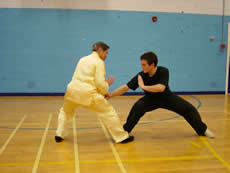
After deflecting Sifu Wong's attack, Ronan immediately shoots out his punch at Sifu Wong's right ribs. Sifu Wong sinks his stance backward to avoid Ronan's attack and simultaneously glides back his left hand to grip Ronan's right wrist with a tiger-claw.
Question 4
I have one or more Buddhist monks due to attend my classes and I am not sure how to address them, either in class or out of class. I humbly consider myself a Buddhist, although not a very good one, and therefore wish to be correct and respectful to monks, be them female or male. Because of who they are and because our great art is Buddhist, I feel to do otherwise would be disrespectful to our ancestors.
— Dan, England
Answer
We normally address a monk (or a nun) as “sifu” (“shifu” in Mandarin). Sometimes he is addressed as “fatt-si” (“fa-shi”), which means “vinaya sifu”, or “sim-si” (“chan-shi”), meditation or Zen sifu. Calling a young monk “sifu” may cause him embarrassment, so some people call him “siu sifu” (“shao shifu”), or small teacher.
However, if he is your student, he will address you as “sifu” instead, and you address him by name. This is so, especially if he is a young monk, just as young monks at the Shaolin Monastery addressed their teacher as “sifu”, and he addressed them by names. His senior classmates will address the monk as “si-dai” (“shi-di” in Mandarin), and he addressed them as “si-heng” (“shi-ziong”), just as a monk did so to his secular senior classmates at the Shaolin Monastery in the past.
But if your monk student is elderly or of some importance, you may address him by name suffixed or prefixed by “sifu” according to Chinese or Western system respectively, e.g. Wei Khong Sifu or Sifu Wei Khong. As a form of courtesy you may like to ask him how he likes to be addressed by you and his classmates.

Then Sifu Wong shoots out his right leopard punch at Ronan's throat while his left tiger-claw grips Ronan's right wrist and pulls Ronan forward. Ronan is in a precarious position. He is being pulled forward, yet a leopard punch is shooting into his throat.
Question 5
I had my left arm dislocated from my shoulder. I was operated upon and it came out that the comb was severely damaged. Fortunately I was operated upon by one of the leading surgeons in the field of orthopedics. He managed to repair the bone and tighten the tissue. A few years ago he already executed the same operation upon my right shoulder.
— Michael, Holland
Answer
Conventional Western medicine and traditional Chinese medicine hold different philosophies and operate from different paradigms. Hence, their views and consequently their treatment methods are different.
A major branch of traditional Chinese medicine is “wei ke” or external medicine. There is no direct equivalent in conventional Western medicine, but the closest is surgery. In fact the Chinese term today for surgery is “wei ke”.
But “wei ke” or “external medicine” in traditional Chinese medicine is not just surgery, though surgery reached a very high level in China in the past. Two thousand years ago, for example, Chinese surgeons successfully operated on the abdomen, the eye and the head. In the West surgery became thinkable only about 300 years ago when Western doctors overcame the problems of antiseptics and anesthesia, As many people think in a dualistic manner, it may be worthwhile to clarify that mentioning these facts is in no way belittling conventional Western medicine, which has, without doubt, contributed greatly to the well-being of our modern world.
One major aspect of “wei ke” or “external medicine” is “shang ke” or “injury medicine”, which also involves internal medicine. Incidentally this shows the non-dualistic thinking in traditional Chinese medicine and other Eastern disciplines. In my book, “The Complete Book of Chinese Medicine”, I translate “shang ke” as “traumatology”, which is known colloquially in Chinese as “die da” (pronounced like “thiet tha” in Mandarin or “tit ta” in Cantonese). Interestingly, "die da" or "tit ta" literally means “fall-hit”. This is because falls and being hits are the two principal causes of traumatic injuries for which this branch of Chinese medicine specially deals with.
In traditional kungfu culture, understanding and practicing traumatology was an essential part of a person's training to become a master. All my four kungfu masters were traumatology experts. One of them, Sifu Ho Fatt Nam, said to me a few times that Shaolin traumatology was the best in the world. He was so good in this field that conventional orthopedists in hospitals routinely redirected their difficult cases to him!
I also have helped many people overcome problems related to bones that conventional orthopedists have found difficult, such as fusing of vertebrae and lack of bone density. Indeed a few orthopedists have shown interested in learning Shaolin traumatology from me, but due to various reasons this has not taken place.
Shoulder dislocations and weakening of shoulder muscles and tendons are comparatively easy in Shaolin traumatology. Surgery is unnecessary. Manipulative techniques, external medicinal application, remedial chi kung and internal medicine are usually sufficient to overcome such problems in a much shorter time and with little or no side effects.
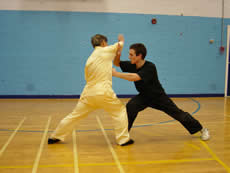
Nevertheless, with a skilful movement of his body, waist and wrist, Ronan reverts a seemingly hopeless situation into one favorable to himself. He sinks his body backward, rotates his waist slightly to his left, circulates his right wrist, then continuing the momentum, moves his body forward, floats Sifu Wong's right arm with his right hand, and strikes Sifu Wong's right ribs with his left palm, using a Shaolin pattern known as “Double Bows Tame Tiger” — all in a continuous smooth action executed in a split second. Now Sifu Wong is in a precarious position.
Question 6
I practice Choy Li Fat Kung Fu and also can perform the genuine Eight Movements as an effective chi kung technique. I learned them from a true master. But what chi kung technique is the most wholesome for revalidating my left shoulder and arm?
Answer
Your attitude here is typical of many people today. They reason that if chi kung is effective in overcoming a particular illness or injury, all they have to do is to ask a chi kung master for the technique and they practice it themselves. It is like telling a doctor that you suffer from a particular disease, and asking him to name the drug that you will purchase yourself from a drug store.
In Chinese traumatology, treating a dislocated shoulder is not merely putting the bone back into its socket. A good traumatologist, like any other good physician, will give you a thorough diagnosis, though he knows that your immediate problem is fixing your shoulder. He will check, for example, if your kidneys and urinary bladder are functioning well, because these two internal organs are related to the bone and muscular systems. Damaged bones and their tissues affect these two organs, and vice versa.
If he uses a thematic approach, a good traumatologist may prescript specific chi kung exercises like “Nourishing Kidneys” and “Big Windmill” to work on the kidneys, urinary bladder and shoulders. If he uses a holistic approach, almost any chi kung exercise can do, though “Self-Manifested Chi Movement” will be recommended.
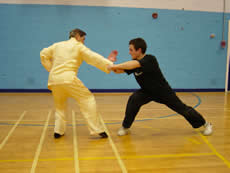
However, also with a skilful movement of his waist, body and arm, Sifu Wong reverts a seemingly hopeless situation. Rotating his waist, body and arm appropriately, and bringing his front right leg backward into a right False-Leg Stance, Sifu Wong sweeps at Ronan's left wrist with his right palm using the pattern “False Leg Hand Sweep”.
Question 7
Choy-Li-Fatt is an aggressive style. I found it wise to change to a milder, more internal style. Which one you think is the most suited for me now?
Answer
How you are taught and how you practice it is more important than what style you practice. Under a good master, Choy-Li-Fatt is excellent for overcoming your shoulder problem, whereas a mediocre internal style instructor may just teach you external forms which may aggravate your problem if you practice it incorrectly. However, if all things were equal, genuine Taijiquan is probably your best choice.
